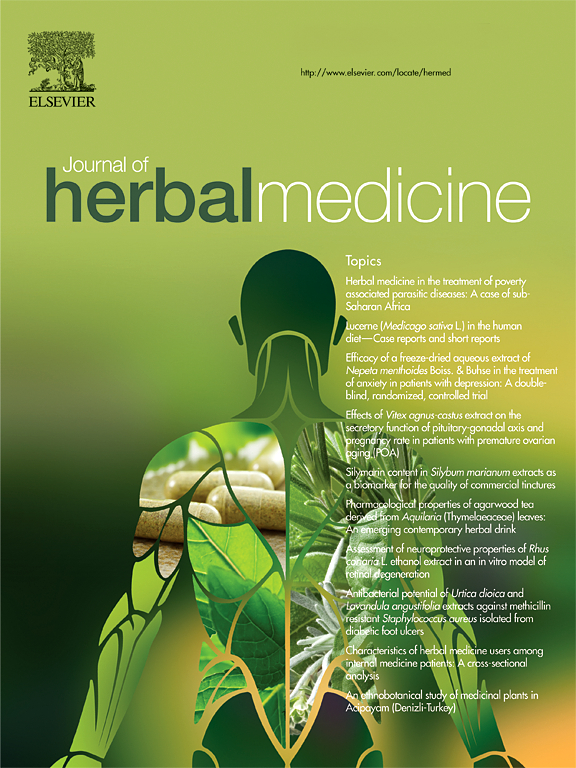Efficacy and safety of Pueraria lobata radix-containing traditional Chinese medicine in the treatment of essential hypertension: a systematic review
IF 1.9
4区 医学
Q2 INTEGRATIVE & COMPLEMENTARY MEDICINE
引用次数: 0
Abstract
Introduction
This study aims to systematically review the efficacy and safety of Pueraria lobata radix (Chinese name: Ge Gen) prescriptions (GGPs) of traditional Chinese medicine in treating hypertension.
Methods
We searched seven databases for randomised controlled trials (RCTs) comparing GGPs plus antihypertensive drugs versus antihypertensive drugs alone for essential hypertension. Primary outcomes were changes in systolic blood pressure (SBP) and diastolic blood pressure (DBP), while secondary outcomes included 24hSBP, 24hDBP, responses to antihypertensive treatment, control of hypertensive symptoms, blood glucose and lipid indicators, and incidence of adverse events.
Results
Thirty-one RCTs involving 2 501 patients were included. Compared with antihypertensive drugs alone, GGP adjuvant therapy significantly reduced SBP (mmHg) (mean difference [MD] −10.70, 95% confidence interval [CI] −12.75 to −8.65), DBP (MD −6.78, 95% CI −8.51 to −5.05), and 24hSBP (MD −7.13, 95% CI −10.78 to −3.47), increased the response to antihypertensive treatment (risk ratio 1.21, 95% CI 1.13–1.30) and hypertensive symptom control, and improved levels of total and low-density lipoprotein cholesterol, triglycerides, and blood glucose indicators. However, GGPs had no significant impact on high-density lipoprotein cholesterol (HDL-C) or 24hDBP, although the trial sequential analysis suggested false negatives for these outcomes.
Conclusion
GGPs, when used as complementary therapy, may improve various parameters related to blood pressure, blood lipids, and blood glucose in patients with essential hypertension and show good safety. However, the impact of GGPs on 24hDBP, hypertensive symptoms, and HDL-C remains uncertain due to the limited quality of evidence.
葛根中药治疗原发性高血压的疗效和安全性:系统评价
引言 本研究旨在系统回顾中药葛根汤治疗高血压的疗效和安全性。方法 我们检索了七个数据库中的随机对照试验(RCT),比较了葛根汤加降压药与单用降压药治疗原发性高血压的效果。主要结果是收缩压(SBP)和舒张压(DBP)的变化,次要结果包括 24 小时收缩压(SBP)、24 小时舒张压(DBP)、对降压治疗的反应、高血压症状的控制、血糖和血脂指标以及不良事件的发生率。与单独使用降压药相比,GGP 辅助治疗可显著降低 SBP(mmHg)(平均差 [MD] -10.70,95% 置信区间 [CI] -12.75 至 -8.65)、DBP(MD -6.78,95% CI -8.51 至 -5.05)和 24hSBP (MD -7.13,95% CI -10.78至-3.47),增加了对降压治疗的反应(风险比为1.21,95% CI为1.13-1.30)和高血压症状的控制,并改善了总胆固醇和低密度脂蛋白胆固醇、甘油三酯和血糖指标的水平。然而,GGPs 对高密度脂蛋白胆固醇(HDL-C)或 24hDBP 没有显著影响,尽管试验序列分析表明这些结果存在假阴性。然而,由于证据质量有限,GGPs 对 24hDBP、高血压症状和高密度脂蛋白胆固醇的影响仍不确定。
本文章由计算机程序翻译,如有差异,请以英文原文为准。
求助全文
约1分钟内获得全文
求助全文
来源期刊

Journal of Herbal Medicine
INTEGRATIVE & COMPLEMENTARY MEDICINE-
CiteScore
3.90
自引率
0.00%
发文量
94
期刊介绍:
The Journal of Herbal Medicine, the official journal of the National Institute of Medical Herbalists, is a peer reviewed journal which aims to serve its readers as an authoritative resource on the profession and practice of herbal medicine. The content areas of the journal reflect the interests of Medical Herbalists and other health professionals interested in the clinical and professional application of botanical medicines. The objective is to strengthen the research and educational base of herbal medicine with research papers in the form of case studies, original research articles and reviews, monographs, clinical trials and relevant in vitro studies. It also publishes policy statements, opinion pieces, book reviews, conference proceedings and profession related information such as pharmacovigilance reports providing an information source for not only the Herbal Practitioner but any Health professional with an interest in phytotherapy.
 求助内容:
求助内容: 应助结果提醒方式:
应助结果提醒方式:


